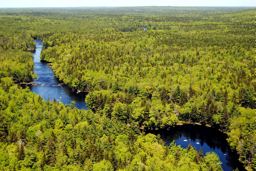 Tusket River Wilderness Area protects over 20 km of undeveloped river and lake shore along Tusket River and its tributaries, including rare plants and some old conifer forest. The protected shoreline includes parts of Pearl Lake, Kegeshook Lake, Canoe Lake, Louis Lake, Gillfillan Lake, Third Lake and Cranberry Lake.
Tusket River Wilderness Area protects over 20 km of undeveloped river and lake shore along Tusket River and its tributaries, including rare plants and some old conifer forest. The protected shoreline includes parts of Pearl Lake, Kegeshook Lake, Canoe Lake, Louis Lake, Gillfillan Lake, Third Lake and Cranberry Lake.
Established in 2015, the wilderness area was expanded by 112 hectares in 2019. About half the expansion was acquired and transferred to the province by the Nova Scotia Nature Trust.
The lake shores and riverbanks host a nationally significant plant community known as Atlantic Coastal Plain Flora. Over a dozen species of at-risk plants occur on these shorelines, including the nationally endangered pink coreopsis and Plymouth gentian. Pockets of old conifer forest are found on some islands along the river.
The wilderness area forms a partial, forested corridor along the river, helping to facilitate wildlife movement and maintain the scenic and recreational value of this waterway and traditional canoe route, including about 13 km along the main branch of the Tusket River. Part of the wilderness area extends 30.5 m (100 feet) into Gillfillan Lake to encompass the lake margin at low water where many rare plants occur.
Hunting, sport-fishing, canoeing and other activities may be enjoyed here, and cottages are found on some of the adjacent private lands.
Certain roads are not part of the wilderness area to allow ongoing vehicle use, including: Coldstream Road, Shunacadie Road, a forest access road between Coldstream Road and East Kempt, and a spur road to Bad Falls. Louis Lake and access to the lake are outside the wilderness area.
Other protected lands in the area include the 38-hectare Tusket River Nature Reserve, established in 1987 and expanded in 2006; as well as a suite of lands protected by the Nature Conservancy of Canada (NCC), Nova Scotia Nature Trust (NSNT), and Tusket River Environmental Protection Association (TREPA). Together, these protected lands reflect a decades long effort by the Province and partners to protect Atlantic Coastal Plain Flora habitat along the Tusket River.

